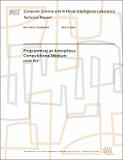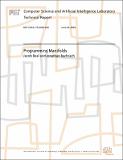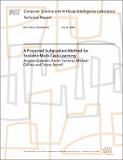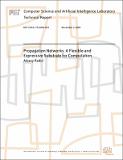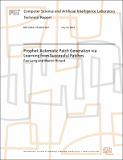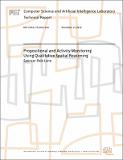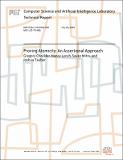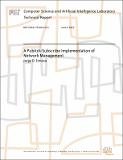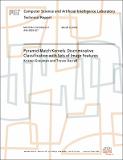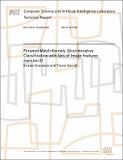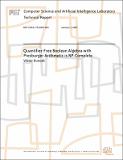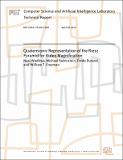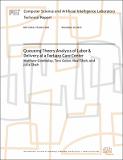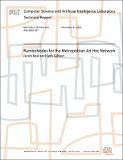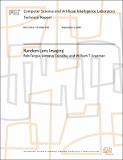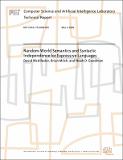Browsing CSAIL Technical Reports (July 1, 2003 - present) by Title
Now showing items 551-570 of 775
-
Programming a Sensor Network as an Amorphous Medium
(2006-06)In many sensor network applications, the network is deployedto approximate a physical space. The network itself is not ofinterest: rather, we are interested in measuring the propertiesof the space it fills, and of establishing ... -
Programming an Amorphous Computational Medium
(2004-09)Amorphous computing considers the problem of controllingmillions of spatially distributed unreliable devices which communicateonly with nearby neighbors. To program such a system, we need a highleveldescription language ... -
Programming Manifolds
(2007)Many programming domains involve the manipulation of values distributed through a manifold - examples include sensor networks, smart materials, and biofilms. This paper describes a programming semantics for manifolds based ... -
A Projected Subgradient Method for Scalable Multi-Task Learning
(2008-07-23)Recent approaches to multi-task learning have investigated the use of a variety of matrix norm regularization schemes for promoting feature sharing across tasks.In essence, these approaches aim at extending the l1 framework ... -
Propagation Networks: A Flexible and Expressive Substrate for Computation
(2009-11-03)I propose a shift in the foundations of computation. Practically all ideas of general-purpose computation today are founded either on execution of sequences of atomic instructions, i.e., assembly languages, or on evaluation ... -
Prophet: Automatic Patch Generation via Learning from Successful Human Patches
(2015-05-26)We present Prophet, a novel patch generation system that learns a probabilistic model over candidate patches from a large code database that contains many past successful human patches. It defines the probabilistic model ... -
Prophet: Automatic Patch Generation via Learning from Successful Patches
(2015-07-13)We present Prophet, a novel patch generation system that learns a probabilistic model over candidate patches from a database of past successful patches. Prophet defines the probabilistic model as the combination of a ... -
Propositional and Activity Monitoring Using Qualitative Spatial Reasoning
(2016-12-14)Communication is the key to effective teamwork regardless of whether the team members are humans or machines. Much of the communication that makes human teams so effective is non-verbal; they are able to recognize the ... -
Proving Atomicity: An Assertional Approach
(2005-07-22)Atomicity (or linearizability) is a commonly used consistency criterion for distributed services and objects. Although atomic object implementations are abundant, proving that algorithms achieve atomicity has turned out ... -
A Publish-Subscribe Implementation of Network Management
(2013-06-04)As modern networks become highly integrated, heterogeneous, and experience exponential growth, the task of network management becomes increasingly unmanageable for network administrators and designers. The Knowledge Plane ... -
Pyramid Match Kernels: Discriminative Classification with Sets of Image Features
(2005-03-17)Discriminative learning is challenging when examples are setsof local image features, and the sets vary in cardinality and lackany sort of meaningful ordering. Kernel-based classificationmethods can learn complex decision ... -
Pyramid Match Kernels: Discriminative Classification with Sets of Image Features (version 2)
(2006-03-18)Discriminative learning is challenging when examples are sets of features, and the sets vary in cardinality and lack any sort of meaningful ordering. Kernel-based classification methods can learn complex decision boundaries, ... -
Quantifier-Free Boolean Algebra with Presburger Arithmetic is NP-Complete
(2007-01-01)Boolean Algebra with Presburger Arithmetic (BAPA) combines1) Boolean algebras of sets of uninterpreted elements (BA)and 2) Presburger arithmetic operations (PA). BAPA canexpress the relationship between integer variables ... -
Quantitative Information Flow as Network Flow Capacity
(2007-12-10)We present a new technique for determining how much information abouta program's secret inputs is revealed by its public outputs. Incontrast to previous techniques based on reachability from secretinputs (tainting), it ... -
Quantitative Information-Flow Tracking for C and Related Languages
(2006-11-17)We present a new approach for tracking programs' use of data througharbitrary calculations, to determine how much information about secretinputs is revealed by public outputs. Using a fine-grained dynamicbit-tracking ... -
Quaternionic Representation of the Riesz Pyramid for Video Magnification
(2014-04-26)Recently, we presented a new image pyramid, called the Riesz pyramid, that uses the Riesz transform to manipulate the phase in non-oriented sub-bands of an image sequence to produce real-time motion-magnified videos. In ... -
Queueing Theory Analysis of Labor & Delivery at a Tertiary Care Center
(MIT CSAIL, 2014-12-16)Labor and Delivery is a complex clinical service requiring the support of highly trained healthcare professionals from Obstetrics, Anesthesiology, and Neonatology and the access to a finite set of valuable resources. In ... -
RamboNodes for the Metropolitan Ad Hoc Network
(2003-12-17)We present an algorithm to store data robustly in a large, geographically distributed network by means of localized regions of data storage that move in response to changing conditions. For example, data might migrate away ... -
Random Lens Imaging
(2006-09-02)We call a random lens one for which the function relating the input light ray to the output sensor location is pseudo-random. Imaging systems with random lensescan expand the space of possible camera designs, allowing new ... -
Random-World Semantics and Syntactic Independence for Expressive Languages
(2008-05-03)We consider three desiderata for a language combining logic and probability: logical expressivity, random-world semantics, and the existence of a useful syntactic condition for probabilistic independence. Achieving these ...


